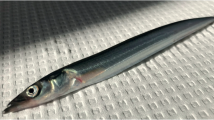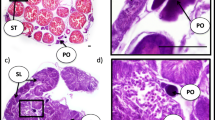Synopsis
In immature and adult females of protogynous gobies, small distinctive masses of cells associated with the ovarian wall develop into testis-associated glandular structures during sex change. These precursive accessory gonadal structures, or pAGS, have been found in females of known protogynous goby species, but not among gonochoric goby species, suggesting that their presence can be used as a species-specific indicator of protogyny within the family. However, a detailed examination of a developmental series of ovaries in two gonochoric species,Gobiosoma illecebrosum andG. saucrum, revealed the presence of a gonadal feature previously thought to be restricted to protogynous gobies. Among immature females of both species, pAGS-like structures having a similar appearance and placement as functional pAGS of protogynous gobies were found. In femaleG. illecebrosum, the size of these structures among immatures progressively decreased with maturation and were absent in all but the smallest adult females. A similar pattern was evident in a small sample ofG. saucrum. Population demography based on field collections showed thatG. illecebrosum exhibits sex ratios and male and female size-frequency distributions typical of gonochores and laboratory experiments indicated that final sexual identity was unaffected by social environment during the juvenile period. Thus, the presence of pAGS in juvenile femaleG. illecebrosum is not related to an ability to change sex at that ontogenic interval. Whether the transient pAGS observed here are vestiges of an ancestral protogynous condition is unknown. Based on their presence among immatures in two gonochore gobies, however, only the presence of pAGS in adult females should be used to predict protogyny among gobies.
Similar content being viewed by others

References cited
Arai, R. 1964. Sex characters of Japanese gobioid fishes (I). Bull. Nat. Sci. Mus. Tokyo 7: 295–306.
Birdsong, R.S., E.O. Murdy & F. Pezold. 1988. A study of vertebral column and median fin osteology in gobioid fishes with comments on gobioid relationships. Bull. Mar. Sci. 42: 174–214.
Charnov, E. 1982. Alternative life-histories in protogynous fishes: a general evolutionary theory. Mar. Ecol. Prog. Ser. 9: 305–309.
Cole, K.S. 1983. Protogynous hermaphroditism in a temperate territorial marine goby,Coryphopterus nicholsi. Copeia 1983: 809–812.
Cole, K.S. 1988. Predicting the potential for sex-change on the basis of ovarian structure, in gobiid fishes. Copeia 1988: 1082–1086.
Cole, K.S. 1990. Patterns of gonad structure in hermaphroditic gobies (Teleostei: Gobiidae). Env. Biol. Fish. 28: 125–142.
Cole, K.S. & D.R. Robertson. 1988. Protogyny in a Caribbean reef goby,Coryphopterus personatus: gonad ontogeny and social influences on sex change. Bull. Mar. Sci. 42: 317–333.
Cole, K.S. & D.Y. Shapiro. 1990. Gonad structure and hermaphroditism in the gobiid genusCoryphopterus (Teleostei: Gobiidae). Copeia 1990: 966–973.
Egami, N. 1960. Comparative morphology of the sex characters in several species of Japanese gobies, with reference to the effects of sex steroids on the characters. J. Fac. Sci. Univ. Tokyo, Ser. IV 9: 67–100.
Fishelson, L. 1970. Protogynous sex reversal in the fishAnthias squamipinnis (Teleostei, Anthiidae) regulated by the presence or absence of a male fish. Nature 227: 90–91.
Fishelson, L. 1975. Ecology and physiology of sex reversal inAnthias squamipinnis (Peters), (Teleostei, Anthiidae). pp. 284–294.In: R. Reinboth (ed.) Intersexuality in the Animal Kingdom, Springer Verlag, New York.
Fishelson, L. 1989. Bisexuality and pedogenesis in gobies (Gobiidae: Teleostei) and other fish, or why so many little fish in tropical seas? Senckenbergia marit. 20: 147–169.
Fishelson, L. 1992. Comparative gonad morphology and sexuality of the Muraenidae (Pisces, Teleostei). Copeia 1992: 197–209.
Fricke, H.W. 1983. Social control of sex: field experiments with the anemonefishAmphiprion bicinctus. Z. Tierpsychol. 61: 71–77.
Fricke, H.W. & S. Fricke. 1977. Monogamy and sex change by aggressive dominance in a coral reef fish. Nature 266: 830–832.
Hoese, D.F. 1984. Gobioidei: relationships. pp. 588–591.In: H.G. Moser et al. (ed.) Ontogeny and Systematics of Fishes, Spec. Pub. No. 1, Am. Soc. of Ichthy. and Herpet., Allen Press, Lawrence.
Lassig, B.R. 1977. Socioecological strategies adopted by obligate coral-dwelling fishes. pp. 565–570.In: D.L. Taylor (ed.) Proc. Third Intern. Coral Reef Symp. I, Biology, Miami.
Miller, P.J. 1984. The tokology of gobioid fishes. pp. 119–153.In: G.W. Potts & R.J. Wootton (ed.) Fish Reproduction: Strategies and Tactics, Academic Press, New York.
Nelson, J.S. 1984. Fishes of the world, 2nd ed. John Wiley and Sons, New York. 416 pp.
Robertson, D.R. 1972. Social control of sex reversal in a coral reef fish. Science 177: 1007–1009.
Robertson, D.R. & G. Justines. 1982. Protogynous hermaphroditism and gonochorism in four Caribbean reef gobies. Env. Biol. Fish. 7: 137–142.
Robertson, D.R. & R.R. Warner. 1978. Sexual patterns in the labroid fishes of the western Caribbean, II. The parrot fishes (Scaridae). Smithsonian Contributions to Zoology 255: 1–26.
Ross, R.M., G.S. Losey & M. Diamond. 1983. Sex change in a coral reef fish: dependence of stimulation and inhibition on relative size. Science 221: 574–575.
St. Mary, C.M. 1994. Novel sexual patterns in two simultaneously hermaphroditic gobies,Lythrypnus dalli andLythrypnus zebra. Copeia (in press).
Shapiro, D.Y. 1979. Social behavior, group structure and the control of sex reversal in hermaphroditic fish. Advances in the Study of Behavior 10: 43–102.
Shapiro, D.Y. 1981. Size, maturation and the social control of sex reversal in the coral reef fishAnthias squamipinnis (Peters). J. Zool. (Lond.) 193: 105–128.
Shapiro, D.Y. 1987. Differentiation and evolution of sex change in fishes. BioScience 37: 490–497.
Shapiro, D.Y. & R. Lubbock. 1980. Group sex ratio and sex reversal. J. Theor. Biol. 82: 411–426.
Sokal, R.R. & F.J. Rohlf. 1981. Biometry. The principles and practice of statistics in biological research, 2nd ed. W.H. Freeman and Company, San Francisco. 859 pp.
Warner, R.R. 1978. The evolution of hermaphroditism and unisexuality in aquatic and terrestrial animals. pp. 78–101.In: E.S. Reese & F.J. Lighter (ed.) Contrasts in Behavior, John Wiley & Sons, New York.
Warner, R.R. 1988. Sex change in fishes: hypotheses, evidence and objectives. Env. Biol. Fish. 22: 81–90.
Author information
Authors and Affiliations
Rights and permissions
About this article
Cite this article
Cole, K.S., Robertson, D.R. & Cedeno, A.A. Does gonad structure reflect sexual pattern in all gobiid fishes?. Environ Biol Fish 41, 301–309 (1994). https://doi.org/10.1007/BF00023819
Received:
Accepted:
Issue Date:
DOI: https://doi.org/10.1007/BF00023819



